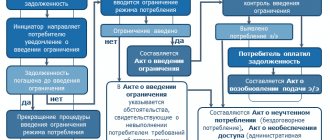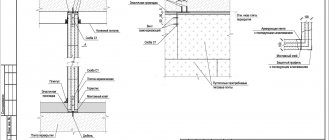G. Alekseev Author of the article
In this article we talk about typical options for resolving legal issues, but each case is unique. Take advantage of a free consultation specifically for your specific case, call right now by phone: (it’s free) +7 Moscow +7 St. Petersburg +7 ext. 636 - 24-hour toll-free line throughout Russia
The issue of distinguishing between balance sheet and operational responsibilities becomes relevant when a management company or homeowners association is going to enter into an agreement on the supply of resources with a supplying organization. It is necessary to determine the division for cases of accidents in networks that are not related to common property, since under the contract such an obligation, as well as the financial burden for maintenance, can be assigned to the HOA or management company, and therefore to the homeowners.
Legislative basis for the issue
The conclusion of contracts regarding energy supply is regulated by the Civil Code. Article 539 defines the boundaries of exploitation as follows:
- the supplying organization is obliged to supply energy to consumers;
- The consumer is obliged to pay for this energy, comply with the regime of its consumption specified in the contract and ensure the serviceability of the networks and the safety of their use.
In this case, the subscriber receiving electricity must have:
- energy receiving device;
- connection to the networks of a resource supplying organization;
- energy consumption meters;
- other necessary equipment.
As you can see from this list, the resource recipient has many more responsibilities than the supplier. This is why the demarcation document plays an important role: it allows the recipient of services to be spared unnecessary activities and costs.
Important nuance
In the agreement (act) of the boundaries of balance sheet and operational responsibility, as a rule, utility networks related to common property and other utility networks are separated. For this reason, it is important to understand what directly relates to common property:
- Premises of an apartment building that are not considered part of the apartments. They must be designed for more than one room. And it doesn’t matter whether the premises are residential or not.
- Engineering systems for gas supply, cold and hot water supply, electricity supply and heating inside the apartment building.
The boundaries of operational responsibility of water supply networks or any other are divided into internal and external. The latter divide the spheres of authority of the management company and the resource-providing organization. Internal boundaries regulate issues between the owners and the management company. Let's talk about this topic in more detail.
Difference of concepts
The concept of balance sheet ownership (BP) is inextricably linked with operational responsibility (EO). There is no precise definition of both terms in current legislation. However, they can be determined using a number of theses enshrined in legal norms.
So, for example, clause 2 of Section I “General Provisions” of the Water Supply Rules (approved by Government Decree No. 644 of July 29, 2013) defines the following concepts:
- the limits of the BP as the dividing line of water supply and/or drainage systems between users on the basis of ownership, economic management or operational management;
- limits regarding operation as a dividing line of water supply and/or drainage systems between users based on the responsibilities accompanying the use of water supply networks.
The EO section is determined using an agreement between the supplier and the consumer. And if such an agreement is not reached, then responsibility is divided along the border of the business enterprise.
The regulations on heat energy supply do not specify such a division. Thus, in the Letter of the Federal Tariff Service No. SN-570/14 dated February 18, 2005 (clause 31), heat energy is described as a resource allocated to the subscriber at the border of the EO (BP).
Operational responsibility and balance sheet ownership
These two concepts are surprisingly similar to each other, but the legislation of the Russian Federation cannot yet clearly distinguish between them. There are still differences, so we will try to highlight what is special here.
- Balance sheet ownership can be interpreted as who is the actual owner of the water supply equipment.
- But as for the act of delineating operational responsibilities, it talks about who will carry out the repair work of the water supply and sewerage systems and maintain these resources in working order. If a breakdown occurs on the line, it is the party with operational responsibility that will pay for the repair.
In other words, in the first case, pipes from sewerage systems will be divided based on ownership, and in the second case, the burden will be placed on one of the parties in order to maintain the water supply and sewerage systems in proper condition.
As for the scope of distribution of powers, after signing the agreement on balance sheet ownership, they apply only to the house in question. And in the case of operational responsibility, they are negotiated by decision of the parties involved and can be distributed to the entire house, or to some part of the building where a water pipe break most often occurs. If the boundaries are not specified in the act, then the form of the agreement implies the use of the same rules as for balance sheet liability.
What is the act of delimiting the BP and EO parties?
The most accurate and complete descriptions of the paper drawn up regarding the division of responsibilities of the parties in matters of resource supply are contained in clause 2 of section I of the Rules for non-discriminatory access to electricity (approved by Government Decree No. 861 of December 27, 2004). According to this regulatory document:
- the act of delimiting the power supply in relation to the electrical networks - a paper that defines the boundaries of the balance sheet and is drawn up directly when connecting devices for power consumption to the electrical network;
- EO delimitation act is a document that defines the boundaries of operational responsibility and is drawn up when connecting devices for power consumption to the power grid.
From the above definitions it follows that balance sheet ownership depends on the characteristics of legal ownership (a sign of ownership or other legal possession), and EO depends on the burden of maintaining the operated networks placed on the parties.
Composition of the common property of premises owners in apartment buildings.
From the analysis of the above norms it follows that the boundaries of balance sheet ownership depend on the boundaries of ownership, economic management or operational management of utility networks. Therefore, it is necessary to determine where these boundaries lie.
Due to the fact that the management company enters into contracts with the RSO and acquires the appropriate resources in order to provide public services to citizens, the provisions of the Housing Code of the Russian Federation, the Rules for the provision of public services, as well as the Rules for the maintenance of common property regulate the relationship under the resource supply agreement.
According to paragraph 2 of Art. 162 of the Housing Code of the Russian Federation, under the management agreement for an apartment building, the management company undertakes to provide services and perform work for the proper maintenance and repair of common property in such a building and to provide utilities to the owners of premises in the building. Therefore, it is necessary to determine the composition of the common property of the owners and establish whether the boundaries of the balance sheet ownership of utility networks depend on the composition of the common property.
By virtue of paragraph 1 of Art. 36 of the Housing Code of the Russian Federation, the owners of premises in apartment buildings own, by right of common shared ownership, premises in the house that are not parts of apartments and are intended to serve more than one room in a given house, including basements in which there are utilities, roofs, enclosing load-bearing and non-load-bearing structures home, mechanical, electrical, sanitary and other equipment located outside or inside the premises of the house and serving more than one room, the land plot on which the house is located, with elements of landscaping and landscaping and other equipment intended for the maintenance, operation and improvement of this house objects located on the specified land plot.
In accordance with paragraph 1 of Art. 157 of the Housing Code of the Russian Federation, the amount of payment for utility services is calculated based on the volume of consumed utilities, determined by the readings of metering devices, and in their absence - on the basis of standards for the consumption of utility services approved by the state authorities of the constituent entities of the Russian Federation in the manner established by the Government of the Russian Federation.
Consequently, by accepting the management of an apartment building, the management company undertakes to ensure the supply of utility resources, the volume of which is determined by meter readings, as well as the proper operation of all of the above-mentioned common property of the owners of premises in the apartment building. To determine the point of delivery of the corresponding utility resource in the MKD, it is necessary to determine in what place the metering device should be installed, and also answer the question of where the line of operational responsibility lies and the point of delivery of the resource in the absence of a metering device.
In accordance with clause 3 of the Rules for the provision of utility services, a collective (common house) metering device is a measuring instrument used to determine the volume (quantity) of utility resources supplied to the apartment building.
Owners of premises in apartment buildings (if they choose direct management of apartment buildings) and owners of residential buildings pay for volumes (quantities) of cold and hot water, gas, electricity and heat purchased from RSO, as well as for wastewater services provided, based on meter readings installed at the border of networks that are part of the common property of the owners of premises or owned by the owners of residential buildings, with public infrastructure systems, unless otherwise established by the legislation of the Russian Federation (clause 7 of the Rules for the provision of public services).
Clause 3 of the Rules for the Provision of Public Utilities defines that in-house engineering systems include engineering communications and equipment intended for the provision of public services and located on the premises of an apartment building or in a residential building.
From paragraphs 5, 6 and 7 of the Rules for the maintenance of common property it follows that in-house systems of cold, hot water supply, gas supply, heating and electricity supply, as well as collective (common house) metering devices are included in the common property of premises owners.
According to clause 8 of the Rules for the maintenance of common property, the outer boundary of electricity, heat, water supply and sewerage networks, information and telecommunication networks (including wired radio broadcasting networks, cable television, fiber optic networks, telephone lines and other similar networks) included in the composition of the common property is the outer boundary of the wall of the apartment building (unless otherwise established by the legislation of the Russian Federation), and the limit of operational responsibility in the presence of a collective (common house) metering device for the corresponding communal resource is the place of connection of the collective (common house) metering device with the corresponding engineering network included in the apartment building (unless otherwise established by agreement between the owners of the premises and the utility service provider or RSO).
From the totality of the above norms it follows that the point of delivery of the corresponding communal resource and the boundary of operational responsibility is the external border of the networks that are part of the common property of the owners. According to the general rule, this boundary, in the absence of a collective (common house) metering device, is considered to be the outer boundary of the wall of the apartment building, and if it is present, the point of connection of the collective (common house) metering device with the corresponding DSO network included in the apartment building.
In practice, there are often cases when the common property of the owners does not end at the border of the wall of an apartment building. Accordingly, the delivery point and the boundaries of balance sheet ownership and operational responsibility are not determined by the outer boundary of the wall of the apartment building.
This is consistent with the provisions of Art. 36 of the Housing Code of the Russian Federation, on the basis of which the common property includes, in particular, the land plot on which the apartment building is located, with elements of landscaping and improvement, and other objects intended for the maintenance, operation and improvement of this house, located on the specified land plot. The boundaries and size of this land plot are determined in accordance with the requirements of land legislation and legislation on urban planning.
Purpose and meaning of the agreement on the separation of EO and BP
The balance sheet line separates common property in an apartment building from everything else. Property that is common to residents of apartment buildings is determined by Article 36 of the Housing Code.
As a result of signing the act, each of the parties is aware of which section of the networks it is responsible for, and at whose expense communications will be repaired in the event of an accident. By the way, if it is impossible to determine the EO and the division of responsibilities occurs in accordance with the BP, it should be borne in mind that the latter is installed along the external wall of the building or structure. In contrast, the EO boundary can:
- be determined by agreement between the supplier and the consumer;
- coincide with BP;
- take place at the point where the common house metering device is connected to the MKD network.
The act is signed in order to document the boundaries separating the responsibilities of the organization supplying the resources and their recipient. However, it is also possible that the parties cannot reach an agreement due to an unreasonable shift in boundaries by the supplier company towards expanding the range of responsibilities of the subscriber. Then you will have to share responsibility in court.
Water supply
What is the limit of operational responsibility of water supply networks? In this case, the RSO is responsible to the point of connection between the common building metering device and the water supply network, which is included in the apartment building. The management company must monitor the condition of the cold and hot water supply risers, shut-off devices on the hoses, as well as the condition of the shut-off and control frame of the internal wiring itself.
How is the act drawn up?
Typically, the drawing up of a document assigning corresponding responsibilities to each of the parties to the resource supply agreement is carried out by the supplier company. If this does not happen, you need to send the following documents to the resource supplying organization:
- an extract from the Unified Real Estate Register (to confirm ownership);
- a copy of the construction permit in accordance with Art. 51 of the Town Planning Code;
- a copy of the commissioning act (Article 55 of the Civil Code).
After this, it will be possible to obtain an act of delimitation of balance sheet and operational responsibility.
The main points of the segregation of responsibilities document are as follows:
- “hat” with the details of the act;
- main part: details of the supplier, recipient, location and technical characteristics of the object in relation to which the scope of responsibility is distributed, communication scheme;
- final part: determining the division of responsibilities of the parties.
The document does not have a mandatory, clearly established form; it simply must contain all the listed blocks in accordance with the general rules of office work. No special form is required for this either.
The document is drawn up in three copies: for the consumer, for the supplier and for the controlling organization. In this case, it is signed by both parties.
Act of delineation of operational responsibility
No residential or non-residential building can be put into operation if utilities such as water supply and sewerage are not connected to it. To regulate the supply of these resources, companies must enter into contracts that delineate operational responsibilities.
The purpose of these contracts is that customers receive water supply or water consumption services, and the company that provides these services receives the agreed payment for its work.
Dear readers!
Our articles talk about typical ways to resolve legal issues, but each case is unique. If you want to find out how to solve your specific problem, please contact the online consultant form on the right →
It's fast and free!
Or call us by phone (24/7):
If you want to find out how to solve your particular problem, call us by phone. It's fast and free!
+7 Moscow,
Moscow region
+7 Saint Petersburg,
Leningrad region
+7 Regions
(the call is free for all regions of Russia)
Here are a couple more rules that are observed when signing the act of delineation of responsibility:
- Subscribers are forced to maintain the equipment entrusted to them in technically sound condition. If a breakdown occurs due to the subscriber’s fault, then it is he who should be responsible for repairing it.
- As a rule, an agreement must be concluded not just between two persons, but between a management company, a commercial enterprise or a private housing association. As for the second party, it is expected that it will be a resource supplying institution.
- If the accident is not the fault of the user, then the subscriber faces a dilemma - who exactly should be responsible for this malfunction and remove it in order to restore normal operation of the sewerage or water supply system. Where to call and who to contact? This is what the act will allow us to find out.
- It indicates what level of subordination belongs to each party. The scope of authority may be different in different cases, so this point must be outlined.
FAQ
Is it possible to delineate the responsibilities of the parties to an energy supply agreement as follows: so that the boundary passes at the entrance of communications into a private house, and the supplier organization is responsible for maintaining the networks within the boundaries of the consumer’s site?
No you can not. The issue of passing the boundaries of responsibility is regulated by Decree of the Government of the Russian Federation No. 861 of December 27, 2004, and clause 13 states that the consumer must be responsible for the state of communications within his site, while the supply company is responsible for outside it.
Who is responsible for eliminating the consequences of an accident caused by a burst heated towel rail pipe?
If, in accordance with the report drawn up by the plumber called to the accident, the cause of the flooding is a rupture of the heated towel rail pipe, then the management company is responsible for this, since according to clause 6 of the Government of the Russian Federation No. 491 of June 13, 2006, this pipe belongs to the common property of the house.
The law includes the heating system in the category of common property of apartment buildings: risers, heaters, regulators and shut-off valves, general house heat metering devices and other elements of the heating system.
Heat supply
In order to determine the boundary of operational responsibility and balance sheet responsibility, the following principles must be observed: resource supply organizations are responsible for the heating network until the point of connection between the common house appliance and the heating network entering the house is reached. The management company, in turn, is responsible for the shut-off devices on the riser branches, the heating system risers themselves, as well as for the shut-off and control valves that are located on the intra-apartment wiring.
As for residents, the limit of operational responsibility of heating networks begins inside the apartment. They are responsible for the branches of the heating system risers after the shut-off and control frame and heating devices.
Basic Concepts
The article discussed the boundaries of operational and balance sheet ownership, but the concepts of these terms were not given.
The boundary of balance sheet ownership is the line of division of elements of sewerage systems, water supply and structures on them between owners on the basis of ownership, operational management and economic management.
It turns out that the act of delimiting the balance sheet ownership of electrical networks is a document that is drawn up during the technological connection of energy installations of legal entities and individuals to the electrical networks that define the boundaries of the balance sheet ownership.
The boundary of operational responsibility is the line dividing sections of sewerage systems, water supply and other engineering networks according to the principle of responsibility for the use of elements of engineering systems, which is established by the act of delineation of responsibility. Let us repeat that if there is no document, then the border is set according to the balance sheet. By the way, as for electricity supply, this rule does not apply there. The Letter of the Federal Tariff Service of Russia from 2005 states that the supplied thermal energy is already considered thermal energy, on the border of balance sheet and operational responsibility.
An act of delimitation of responsibilities of the parties is a document drawn up by the consumer and the network organization for the transmission of the electrical network at the junction of energy-receiving devices. They also determine the boundaries of the parties’ responsibility for the use of certain energy-receiving devices and power grid facilities.
Internal boundaries
The boundaries of the operational responsibility of a sewerage system or other network, in addition to external ones, can also be internal. These boundaries are drawn between the owners and the management company. So, the determination of the internal boundaries of operational responsibility must be carried out according to the law. And the last one says the following:
- The boundary is determined by the valves on the heating pipeline connections to the radiator in the apartment. If there is nothing like that, then the section goes along the threaded connection of the radiator plug. This applies to the heating network.
- For hot and cold water supply, the boundary will be the valve at the point where the pipeline drains from the riser. If it is missing, then such a place will be a weld in the same place.
- In drainage, the boundary passes along a cross, tee or branch on the pipeline riser.
- As for the power supply, the boundary in this case is the connection point between the wire coming from the apartment and the electricity meter, RCD, and circuit breaker.
The boundary of operational responsibility of the owner and management company is the inner surface of the apartment walls, front door and windows. All enclosing load-bearing structures, collective parking lots, playgrounds and other land plots that are located near the house, corridors, landings, attics, roofs and elevators belong to the responsible area of the management company.








